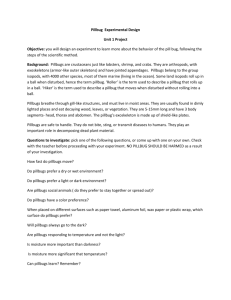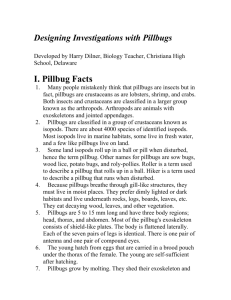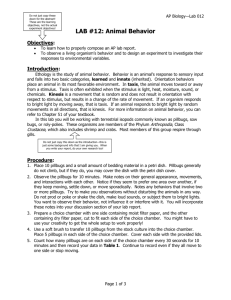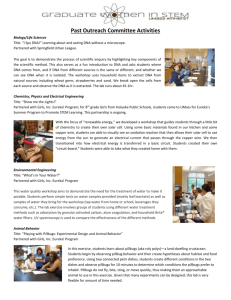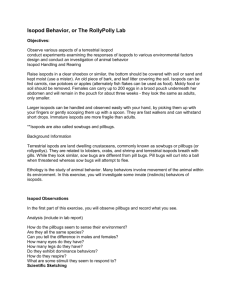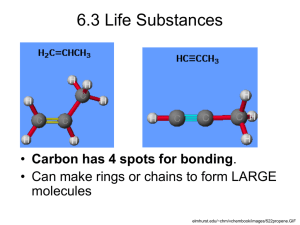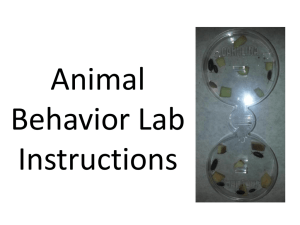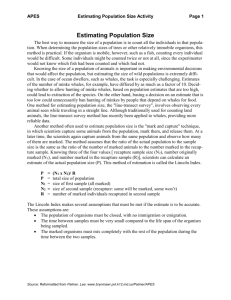Sample - Testbank Offical
advertisement
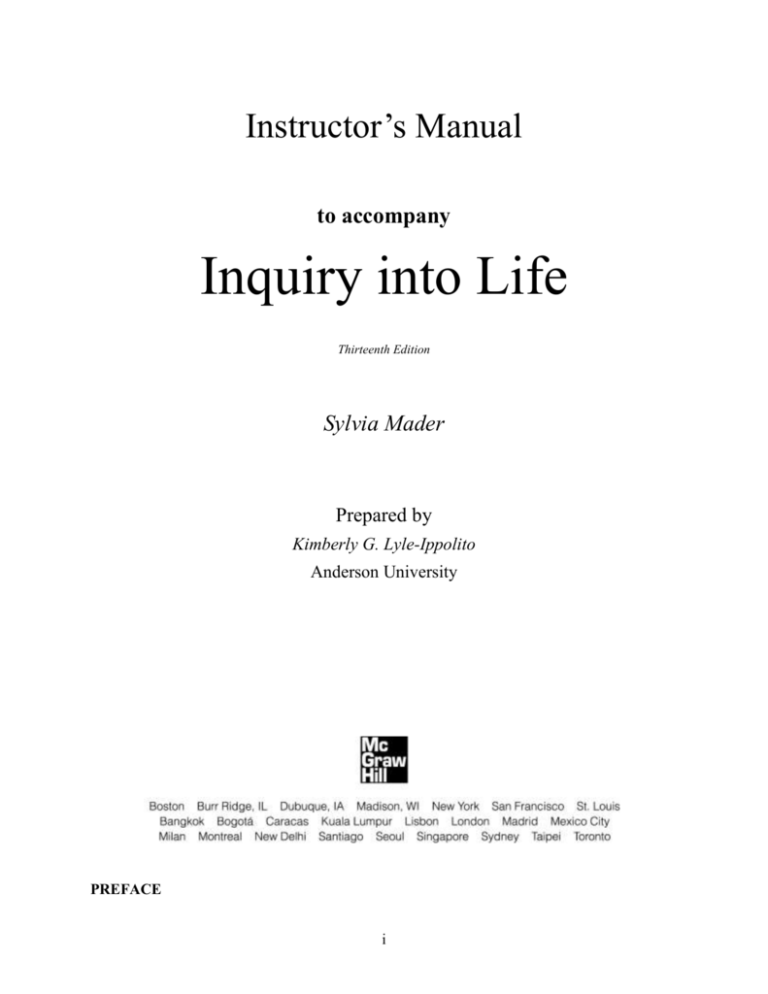
Instructor’s Manual to accompany Inquiry into Life Thirteenth Edition Sylvia Mader Prepared by Kimberly G. Lyle-Ippolito Anderson University PREFACE i Inquiry into Life is a textbook for college freshman biology courses and covers the whole field of basic biology. The textbook emphasizes the application of biology to human life and the relationship of humans to other organisms. Students should discover basic biology principles and also understand that biology concepts are relevant to everyday living. This Instructor’s Manual is designed to assist you as you plan and prepare for classes using Inquiry into Life. ORGANIZATION OF THE INSTRUCTOR’S MANUAL Chapter Contents Learning Outcomes Learning outcomes presented in the Instructor’s Manual give the instructor a quick overview of the major themes covered in the chapter. Lecture Outline Each chapter in Inquiry into Life begins with a “Chapter Outline.” This outline is expanded with annotations in the Instructor’s Manual and has several functions. An instructor can use it for his/her lecture notes since it contains the important concepts from the textbook and is cross-referenced to topic heads in the textbook. The outline can be made into Microsoft Office PowerPoint slides so the students can follow along with the lecture. Or an instructor may reproduce the extended outline to give to students before or after the lecture on that particular chapter. The organization of lecture concepts is a critical decision made by each instructor. A disorganized presentation is more difficult for students to follow and the distinct concepts may not build to an overall understanding. The selection of examples to illustrate concepts, and the selection of which concepts to represent and what order they should be presented, are critical factors in good teaching. The organization given here reflects the organization and voice of the textbook author, Dr. Sylvia Mader. Connections & DVD Resources Each chapter in the Instructor’s Manual lists web addresses for online connections that are useful for finding further information and examples for teaching. DVD resources provide visual learning assistance for students. Producers have usually indicated their materials are appropriate for adult and college levels, and titles are listed without any recommendation as to the content, quality, or year of production. Further information can be obtained by contacting the distributors. Lecture Enrichment Ideas This section suggests unique presentation and lecture strategies and methods to involve students in and out of the classroom. These topics and projects are not all-inclusive, but may help an instructor try something new and increase the interest of students. Lists of suggested term paper topics are provided so a teacher doesn’t have to “reinvent the wheel.” Essay Questions with Answers Each section contains several essay questions with answers for inclusion on student performance evaluations. DISTRIBUTORS OF DVDS ii Amazon.com http://www.amazon.com/ Ambrose Video Publishing, Inc. 145 W. 45th Street, Suite 1115 New York, NY 10036 1-800-526-4663 http://www.documentary-video.com/order.cfm Annenberg Media PO Box 55742 Indianapolis, IN 46205-0742 1-800-532-7637 http://www.learner.org/index.html Carolina Biological Supply 2700 York Road Burlington, NC 27215-3398 1-800-334-5551 http://www.carolina.com/home.do Educational Video Network 1401 19th Street Huntsville, TX 77340 1-800-762-0060 https://www.evndirect.com/index.php Films Media Group Films for the Humanities and Sciences 200 American Metro Blvd., Suite 124 Hamilton, NJ 08619 1-800-257-5126 http://ffh.films.com Garland Science Mortimer House 37-41 Mortimer Street London, W1T 3JH GB 365 4626 36 http://www.garlandscience.com/textbooks/0815342233.asp Great Pacific Media P.O. Box 26243 Colorado Springs, CO 80936 1-800-325-1956 http://www.greatpacificmedia.com/product_p/Glycolysis_dvd.htm National Geographic Catalog/Online 777 South State Road 7 Margate, FL 33068 iii 1-888-225-5647 http://shop.nationalgeographic.com/ PART I: CELL BIOLOGY CHAPTER 1: THE STUDY OF LIFE iv LEARNING OUTCOMES 1.1 The Characteristics of Life 1. Describe the characteristics of living things. 2. Place the levels of biological organization in a hierarchy. 1.2 The Classification of Living Things 1. Describe how living things are classified. 1.3 The Organization of the Biosphere 1. Describe how life is organized on the planet. 2. Discuss how humans influence ecosystems. 1.4 The Process of Science 1. Formulate a hypothesis. 2. List the steps in conducting a scientific experiment. 3. Interpret a controlled study. 1.5 Science and Social Responsibility 1. Discuss the costs and benefits of technology. LECTURE OUTLINE 1.1 The Characteristics of Life The diversity of life seems overwhelming, and yet all living things have certain characteristics in common. Living Things Are Organized A cell is the smallest unit of life. Living things can be organized in a hierarchy of levels. Living Things Acquire Materials and Energy Living things cannot maintain their organization or carry on life’s other activities without an outside source of materials and energy. Living Things Reproduce Life comes only from life. Living Things Respond to Stimuli Living things respond to external stimuli, often by moving toward or away from a stimulus. Living Things Are Homeostatic Homeostasis means “staying the same.” The internal environment of an organism stays relatively constant. Living Things Grow and Develop Growth, recognized by an increase in the size of an organism and often in the number of cells, is a part of development. Living Things Have the Capacity to Adapt Individuals of a species that are better suited to a new environment are able to reproduce and pass on these characteristics. Evolution explains both the unity and diversity of life. 1.2 The Classification of Living Things Since life is so diverse, it is helpful to group organisms according to their similarities. Domains Domains are the largest classification category. There are three domains: Archaea, Bacteria, and Eukarya. Kingdoms v Systematists are in the process of deciding how to categorize archaea and bacteria into kingdoms. The eukaryotes are currently classified into four kingdoms: protists, fungi, plants, and animals. Other Categories The other classification categories are phylum, class, order, family, genus, and species. Scientific Names Taxonomy is the assignment of a binomial, or two-part name, to each species. Scientific names are in a common language—Latin. 1.3 The Organization of the Biosphere The organization of life extends beyond the individual to the population, community, ecosystem, and finally the biosphere (the zone of air, land, and water at the surface of Earth where living organisms are found). The Human Species The human species tends to modify existing ecosystems for its own purposes. Humans depend on healthy ecosystems for food, medicines, and various raw materials. Biodiversity Biodiversity encompasses the total number of species, the variability of their genes, and the ecosystems in which they live. 1.4 The Process of Science Biology is the scientific study of life. Observation Natural events can be understood more fully by observing and studying them. Hypothesis After making observations and gathering knowledge about a phenomenon, a scientist comes up with a hypothesis, a tentative explanation for the natural event. Experiment/Further Observations Testing a hypothesis involves either conducting an experiment or making further observations. Data The results of an experiment are referred to as the data. Data should be observable and objective, rather than subjective or based on opinion. Conclusion Scientists must analyze the data in order to reach a conclusion as to whether the hypothesis is supported or not. Scientific Theory The ultimate goal of science is to understand the natural world in terms of scientific theories, concepts that join together well-supported and related hypotheses. A Controlled Study Most investigators do controlled studies in which the experimental group receives a treatment and the control group receives no treatment. The Experiment The pigeon pea plant is a legume with a high rate of atmospheric nitrogen conversion. A hypothesis was outlined involving winter wheat and nitrogen fertilizer. The Results The results indicated that the hypothesis is not supported. Continuing the Experiment The investigators modified the hypothesis to involve sustained effects. The Results The hypothesis was supported. Ecological Importance of This Study vi This study showed that the use of a legume improved the soil to produce a better yield than the use of a nitrogen fertilizer over the long haul. 1.5 Science and Social Responsibility The application of scientific knowledge for a practical purpose is called technology. Most technologies have benefits, but also drawbacks. Since making value judgments is not a part of science, ethical and moral decisions about technology must be made by all people. CONNECTIONS Committee for the Scientific Investigation of Claims of the Paranormal (CSICOP) investigates and exposes pseudoscience and publishes the Skeptical Inquirer (6/year); highly useful examples of applying science attitudes to psychic claims, etc. Available from Skeptical Inquirer, http://www.csicop.org The National Academies of Science provides a guide to research issues in the life sciences at http://nationalacademies.org/ The Skeptics Society has a similar mission to CSICOP but does not pursue UFO and BigFoot claims and has a narrower and more intellectual focus; publishes The Skeptic available from http://www.skeptic.com Sigma Xi, the Research Society discusses science attitudes and fraud in its publication Honor in Science available at a small cost, http://www.sigmaxi.org Virtual Institute of Cryptozoology is the website for the ISC dedicated to investigating reports of rarely seen animals at http://perso.wanadoo.fr/cryptozoo/method.htm DVD RESOURCES Biotechnology in the 21st Century, ISBN 978-1-60825-071-4, Films for the Humanities and Science, http://ffh.films.com Introduction to Designing Experiments, ISBN 978-1-4213-5431-6, Films for the Humanities and Science, http://ffh.films.com Scientific Method, ISBN 978-1-4213-7403-1, Films for the Humanities and Science, http://ffh.films.com LECTURE ENRICHMENT IDEAS 1. Describe the many properties of quartz crystals: that crystals “grow” over time, little crystals are “reproduced” at angles off the sides of parent crystals, the crystal possesses a predictable angular “structure” that is not like the chaotic environment, and sheets of quartz even show a response to environmental stimuli—they convert light to current in a piezoelectric effect! With so many features of life, why isn’t quartz considered living? 2. We are sending additional robot spacecraft to Mars to further investigate the possibility of life on Mars. In the past, we have looked for properties that life expresses on earth: respiration, growth, movement, etc. Discuss whether the model of Earth’s properties of life is the only model possible. 3. Buy a recent tabloid newspaper from the newsstands featuring a pseudoscience topic (students readily recognize these from the grocery checkout stands). Read one brief account of a particularly preposterous assertion and ask what is necessary for a scientist to believe this, what internal contradictions belie its claims, and what tests would be necessary to provide it with scientific legitimacy, etc. 4. Display an assortment of screws, bolts, nails, brads, staples and other fasteners. Ask students to “classify” them in groups for easier display in a store, etc. On what basis do they group screws and bolts, tacks and nails, etc. (common structures, threading, production methods, functions, etc.)? The basis for biological classification is commonly phylogenetic origin but likewise uses common structures and functions. vii 5. Have students propose various scientific experiments based on their observations. Discuss how to control the variables, how to obtain objective data, how to interpret results, and so on. ESSAY QUESTIONS WITH ANSWERS 1. By itself, a virus cannot reproduce, grow and develop, respond to stimuli, take in material and energy from the environment, nor show any adaptation. However, it is organized with a protein coat that surrounds hereditary material. Once inside another living cell, however, the virus takes over the host’s metabolic machinery in order to grow, develop, and reproduce new virus particles. Therefore, is the virus a living or dead organism? Answer: Scientists do not have a unanimous answer to this question because viruses have characteristics of being both alive and dead. Because viruses are unable to carry out metabolic processes themselves, some scientists prefer to consider viruses activated and inactivated. 2. Explain what is scientifically wrong with the following assertions: a. I clang bells each day and there are no tigers around my house; therefore clanging bells drives away tigers. Answer: There is no test with tigers present; therefore there is no cause-and-effect established. b. If water dousing, homeopathic cures, and so on work for just me but not for anyone else, it is still science. Answer: Science is not personal; results must be repeatable. 3. Why does evolution explain both the unity and the diversity of life? Answer: All organisms share the same basic characteristics of life because we all share a common ancestor (unity). During the past 4 billion years, Earth’s environment has changed drastically, and the diversity of life has been shaped by the evolutionary responses of organisms to these changes (diversity). PART I: CELL BIOLOGY CHAPTER 2: THE MOLECULES OF CELLS viii LEARNING OUTCOMES 2.1 Basic Chemistry 1. Define and give examples of matter. 2. Describe the structure of an atom, including the subatomic particles, their charges, and their location. 3. Know how the periodic table is organized. 4. Explain how isotopes differ. 5. Discuss beneficial and harmful uses for radiation. 2.2 Molecules and Compounds 1. Define a molecule and a compound. 2. Compare and contrast ionic and covalent bonds. 3. Explain why water is a polar molecule and how this enables the formation of hydrogen bonds. 2.3 Chemistry of Water 1. Describe the unique properties of water and the advantages of these properties for life. 2. Be able to define an acid and a base and be able to use the pH scale. 3. Recognize the importance of buffers to living organisms. 2.4 Organic Molecules 1. Distinguish inorganic from organic molecules. 2. Define a functional group. 3. Describe how monomers are joined to form polymers. 2.5 Carbohydrates 1. Recognize the structure of a carbohydrate. 2. Compare and contrast different types of carbohydrates. 2.6 Lipids 1. Describe the structure of the various lipids. 2. List the functions lipids play in our bodies. 2.7 Proteins 1. Describe the monomer unit of a protein and how monomer units are assembled into peptides. 2. Explain the primary, secondary, tertiary, and quaternary structures of a protein and describe the relationship between protein structure and function. 2.8 Nucleic Acids 1. Describe the structure of DNA and RNA. 2. Explain the role of ATP in the cell. LECTURE OUTLINE 2.1 Basic Chemistry Matter refers to anything that takes up space and has mass. All matter, both nonliving and living, is composed of certain basic substances called elements. Atomic Structure Elements consist of tiny particles called atoms. Protons, neutrons, and electrons make up atoms. All atoms of an element have the same number of protons. This number is called the atomic number. The atomic mass is the sum of an atom’s protons and neutrons. The Periodic Table The periodic table was constructed as a way to group the elements according to certain chemical and physical characteristics. Isotopes Isotopes are atoms of the same element that differ in their number of neutrons. Low Levels of Radiation ix The chemical behavior of a radioactive isotope is essentially the same as that of the stable isotopes of an element so you can use small amounts of radioactive isotopes as tracers. High Levels of Radiation Radioactive substances in the environment can harm cells, damage DNA, and cause cancer. Electrons The number of electrons in the outer shell determines whether an atom reacts with other atoms. 2.2 Molecules and Compounds A molecule is formed when two or more atoms bond together. When the atoms of two or more different elements bond together, the product is called a compound. Ionic Bonding The transfer of electron(s) between atoms results in ions that are held together by an ionic bond, the attraction of negative and positive charges. Covalent Bonding A covalent bond results when two atoms share electrons in such a way that each atom has an octet of electrons in the outer shell. Molecules have a three-dimensional shape that often determines their biological function. Shape of Molecules The shapes of molecules are necessary to the structural and functional role they play in living things. Nonpolar and Polar Covalent Bonds When the sharing of electrons between two atoms is fairly equal, the covalent bond is said to be nonpolar. The unequal sharing of electrons in a covalent bond results in a slightly negative charge and a slightly positive charge, resulting in a polar covalent bond. Hydrogen Bonding Polarity within a water molecule causes the hydrogen atoms in one molecule to be attracted to the oxygen atoms in other water molecules, forming a hydrogen bond. 2.3 Chemistry of Water The unique properties of water make it essential to the existence of life. Properties of Water The many hydrogen bonds that link water molecules help water absorb heat without a great change in temperature. Water has a high heat of vaporization because hydrogen bonds must be broken before water boils and water molecules vaporize. Water facilitates chemical reactions, both outside and within living systems. Molecules that attract water are said to be hydrophilic, while those that cannot attract water are said to be hydrophobic. Water flows freely and is able to adhere to polar surfaces. The stronger the force between molecules in a liquid, the greater the surface tension. Ice is less dense than liquid water, and therefore ice floats. Acids and Bases When water ionizes, it releases an equal number of hydrogen ions and hydroxide ions. Acid Solutions (High H+ Concentrations) Acids are substances that dissociate in water, releasing hydrogen ions. Basic Solutions (Low H+ Concentration) Bases are substances that either take up hydrogen ions or release hydroxide ions. pH Scale The pH scale is used to indicate the acidity or basicity of solutions. The pH scale ranges from 0 to 14. Buffers and pH x A buffer is a chemical or a combination of chemicals that keeps pH within normal limits. In animals, the pH of body fluids is maintained within a narrow range, or else health suffers. 2.4 Organic Molecules Organic molecules always contain carbon (C) and hydrogen (H). A functional group is a particular cluster of atoms that always behaves in a certain way. A monomer is a simple organic molecule that exists individually or can link with other monomers to form a polymer. Dehydration and hydrolysis reactions interconnect monomers and polymers. 2.5 Carbohydrates Carbohydrates function for quick fuel and short-term energy storage. Carbohydrate molecules are characterized by the presence of the atomic group H—C—OH. Simple Carbohydrates If the number of carbon atoms in a molecule is low, then the carbohydrate is a simple sugar, or monosaccharide. Polysaccharides Long polymers such as starch, glycogen, and cellulose are polysaccharides that contain many glucose units. Starch and Glycogen Starch and glycogen are ready storage forms of glucose in plants and animals, respectively. Cellulose The polysaccharide cellulose is found in plant cell walls. 2.6 Lipids Lipids function as energy storage molecules. Phospholipids form a membrane, and the steroids are a large class of lipids that includes, among others, the sex hormones. Fats and Oils Fats are solid at room temperature while oils are liquid. Fats are usually of animal origin while oils are usually of plant origin. Emulsification Emulsifiers cause fats to mix with water. Saturated and Unsaturated Fatty Acids A fatty acid is a hydrocarbon chain that ends with the acidic group –COOH. Saturated fatty acids have no double covalent bonds between carbon atoms. Unsaturated fatty acids have double bonds between carbon atoms. Phospholipids Phospholipids contain a phosphate group. They are the primary components of cellular membranes. Steroids Steroids have a backbone of four fused carbon rings. Cholesterol is an important steroid. 2.7 Proteins Proteins are polymers of amino acid monomers. An amino acid has a central carbon atom bonded to a hydrogen atom, a –NH2 (amino) group, a –COOH (acid) group, and an R group. Amino acids differ by their R groups. Proteins have various functions in the body. Some are enzymes that speed chemical reactions. Peptides The bond that joins any two amino acids is called a peptide bond. Levels of Protein Organization Proteins have a primary (linear order of amino acids), secondary (alpha helices or beta pleated sheet), and tertiary structure (globular shape). Some proteins exhibit a quaternary structure (more than one polypeptide chain). xi 2.8 Nucleic Acids The two types of nucleic acids are DNA (deoxyribonucleic acid) and RNA (ribonucleic acid). Structure of DNA and RNA Both DNA and RNA are polymers of nucleotides. Every nucleotide is composed of a phosphate, a pentose sugar, and a nitrogen-containing base. DNA is double stranded RNA is single stranded. ATP (Adenosine Triphosphate) ATP is the energy carrier in cells. while CONNECTIONS The Board on Chemical Sciences and Technology addresses current policy questions involving chemistry at http://nationalacademies.org/ The National Center for Biotechnology Information is a good starting point at http://www.ncbi.nlm.nih.gov/ The Salk Institute is a famous research center that conducts fundamental research in biology and health based on molecular and cellular biology; website at http://www.salk.edu DVD RESOURCES The World of Chemistry, ISBN: 1-55946-223-X, Annenberg Media, http://www.learner.org/index.html Chemistry: A Study of Matter, ASIN: B001ULDJYC, Georgia Public Broadcasting, http://www.amazon.com/ LECTURE ENRICHMENT IDEAS 1. The various organic molecules and types of bonds are easily visualized with models and remembered better than when presented on flat pictures in the textbook, videos, or computer screen. 2. Students should research the topic of acid rain on the Internet before coming to class. They should also collect and bring in water samples from their dorm faucets, drinking fountains, rainwater, snow, or a nearby pond or stream. Have pH paper or a pH meter available in class to determine the pH of these samples. Discuss the known or potential effects of acid rain in your particular geographic location, which might include: effects on forests, including interruption of the symbiotic association between trees and their mycorrhizae, depletion of fisheries in lakes, or deterioration of car finishes and statues. 3. Bring in various types of colas and coffee. Have pH paper or a pH meter available in class to determine the pH of these beverages. How acidic are these? Discuss why you can drink such acidic beverages and not damage your stomach. 4. Of the four organic molecules discussed in this section (carbohydrates, lipids, proteins, and nucleic acids), why are nucleic acids the best suited to store and transmit information? What properties of DNA allow these particular functions? 5. Have a chemistry professor, graduate student, technician, or chemist from your town water treatment facility talk to your students about the job opportunities available to those with a background in chemistry. ESSAY QUESTIONS WITH ANSWERS 1. Name five characteristics of water and relate them to the structure of water. Answer: Because electrons orbit around oxygen more than hydrogen, a slight positive charge is present on the hydrogen atoms and a slight negative charge on the oxygen atom, creating a polarity. Hydrogen bonds form between the water molecules, which leads to various characteristics of water: boils at 100 degrees C and freezes at 0 degrees C; absorbs large amounts of heat before it becomes warm and xii evaporates, which helps to maintain constant body temperature; excellent transport medium; ice floats in liquid water (less dense); and dissolves various chemical substances. 2. All proteins have three basic structural levels. Describe those. Why does hemoglobin have a quaternary structure? Answer: The primary structure of a protein consists of the linear sequence of amino acids joined by peptide bonds. The secondary structure comes about when the polypeptide chain takes a particular orientation in space (alpha helix or beta pleated sheet). The tertiary structure represents the final threedimensional shape of the protein. When more than one polypeptide chain is present, a quaternary structure is formed, which is found in hemoglobin. 3. Explain how soaps, when added to oils, will cause the oil to mix with water. Answer: Soaps have a polar and a nonpolar end. The nonpolar ends of the soap project into the nonpolar fat droplet while the polar ends of the soap project outward into the water, which is polar. xiii Laboratory Resource Guide to accompany Inquiry into Life Laboratory Manual Thirteenth Edition Sylvia S. Mader xiv Contents Preface ii Suppliers iii Laboratory Chapter Title References Page 1 2 3 4 5 6 7 8 9 10 11 12 13 14 15 16 17 18 19 20 21 22 23 24 25 26 27 28 29 30 31 1 8 17 26 36 42 48 53 60 68 74 78 85 89 94 98 106 112 115 120 131 138 145 152 158 164 171 178 185 191 194 Scientific Method Metric Measurement and Microscopy Chemical Composition of Cells Cell Structure and Function Mitosis and Meiosis How Enzymes Function Cellular Respiration Photosynthesis Organization of Flowering Plants Reproduction in Flowering Plants Animal Organization Chemical Aspects of Digestion Basic Mammalian Anatomy I Cardiovascular System Basic Mammalian Anatomy II Homeostasis Nervous System and Senses Musculoskeletal System Development Patterns of Inheritance Human Genetics DNA Biology and Technology Evidences of Evolution Microbiology Seedless Vascular Plants Seed Plants Introduction to Invertebrates Invertebrate Coelomates The Vertebrates Sampling Ecosystems Effects of Pollution on Ecosystems Appendix A Common Materials in a Biological Laboratory 201 Appendix B General Preparation Instructions 203 xv Text Chapter Reference 1 3 2 3, 4 5 6 7 8 9 10 11 14 12, 14, 15 12 16, 21 11, 12, 15, 16 17, 18 19 22 23 23, 24 25 27 28 29 29 30 30 31 34 36 Preface Using the Resource Guide for the Laboratory Manual that accompanies Inquiry into Life, 13th edition will help ensure that you and your students have a successful laboratory experience. Each Laboratory Manual chapter has a corresponding Resource Guide chapter. Resource Guide Chapters You will want to become familiar with the sections of each Resource Guide chapter. They are: Special Requirements. This section will alert you to any living organisms that need to be ordered before the semester begins and any required fresh materials that can usually be bought locally. Materials and Preparations. Each main laboratory topic has its own complete materials list (including Carolina Biological Supply catalog numbers) and preparation instructions for the reagents needed. Other helpful information is also given. Each item in a materials list is preceded by a short line. Use these lines to record the quantity you require for each item. Exercise Questions. This section answers all the questions asked of the students and fills in all the tables with expected results. In the Resource Guide, the Laboratory Manual questions are in boldface type for better visibility and the suggested answers are in italics. The expected results in the tables are also in italic. Laboratory Review. Each Laboratory Manual chapter ends with a set of laboratory review questions. Suggested answers to these questions are at the end of the Resource Guide chapters. Appendices. Appendix A of the Resource Guide contains a list of commonly-needed materials in a biological laboratory. This appendix is helpful when you are ordering materials for your supply room before the semester begins. Appendix B consists of laboratory preparation instructions that apply, in general, to all laboratories. Hazardous Procedures and Materials Laboratory instructors have become increasingly concerned about the potential hazards in a laboratory setting. The Laboratory Manual that accompanies Inquiry into Life, 13th edition, includes a page in the preface that is devoted to Laboratory Safety guidelines. In order to have students follow these guidelines, it will be necessary for you to have safety supplies on hand or require that students purchase them before the semester begins. It is recommended that you go over the Laboratory Safety guidelines with students and have them sign this page at the start of the first laboratory. Because of increased awareness of hazards connected with bodily fluids, it is also recommended that each laboratory room have a biohazard waste container for disposal of such materials. Disposable autoclave bags are also available. See Carolina’s Living Organisms: Labware/Bacteriology section. xvi Measurement of Reagents In order to relieve instructors of the necessity of buying and cleaning a large supply of graduated cylinders or pipettes, the Laboratory Manual assumes that students will use beakers or droppers to fill test tubes. Students are told to mark off a given number of centimeters on the tube and to fill to the mark. This methodology also reduces the amount of time students spend measuring out reagents. In order to keep the amount of required reagent to a minimum, you will probably want to use standard or mini test tubes. Mini test tubes can be used as long as the total volume in a given tube does not exceed 9 cm. Volume equivalents for each size test tube are given in the appropriate materials and preparations sections so that you can determine how much reagent you will need for a particular exercise. Instructors may prefer to have students measure reagents using a dropper and counting drops, or using a graduated cylinder or pipette. Suppliers Aldrich/Fluka Chemical Co. 1001 W. St. Paul Ave. Milwaukee, WI 53233 (800) 325-3010 Fax: (800) 240-4668 www.sigmaaldrich.com Bio-Rad Laboratories 2000 Alfred Nobel Dr. Hercules, CA 94547 (800) 424-6723 Fax: (800) 879-2289 www.bio-rad.com Carolina Biological Supply 2700 York Road Burlington, NC 27215-3398 (800) 334-5551 Fax: (800) 222-7112 www.carolina.com Fisher Science Education 4500 Turnberry Dr. Hanover Park, IL 60133 (800) 955-1177 Fax: (800) 955-0740 www.fisheredu.com xvii Frey Scientific P. O. Box 8101 1000 Paragon Parkway Mansfield, OH 44903 (800) 225-3739 Fax: (877) 256-3739 www.freyscientific.com Grau-Hall Scientific P.O. Box 279592 Sacramento, CA 95827 (800) 331 -4728 www.grauhall.com Lab-Aids, Inc. 17 Colt Ct. Ronkonkoma, NY 11779 (800) 381 -8003 Fax: (631) 737-1286 www.labaids.com Modern Biology, Inc. 3710 East 700 South Lafayette, IN 47909 (800) 733-6544 Fax: (765) 523-3397 www.modernbio.com NASCO P.O. Box 901 901 Janesville Ave. Ft. Atkinson, WI 53538-0901 (800) 558-9595 Fax: (920) 563-8296 www.enasco.com Sigma Chemical Co. P.O. Box 14508 St. Louis, MO 63178-9974 (800) 325-3010 Fax: (800) 240-4668 www.sigmaaldrich.com xviii Triarch, Inc. N8028 Union St. Ripon, WI 54971 (920) 748-5125 Fax: (920) 748-3034 www.triarchmicroslides.com USB Corporation 26111 Miles Rd. Cleveland, OH 44128 (800) 321-9322 Fax: (800) 535-0898 www.usbweb.com Sargent-Welch P.O. Box 4130 Buffalo, NY 14217 (800) 727-4368 Fax: (800) 676-2540 www.sargentwelch.com Wards Natural Science Establishment, Inc. P.O. Box 92912 5100 West Henrietta Rd. Rochester, NY 14692-9012 (800) 962-2660 Fax: (585) 334-6174 www.wardsci.com YSI, Inc. 1725 Brannum Lane Yellow Springs, OH 45387 (800) 765-4974 Fax: (937) 767-9353 www.ysi.com xix Laboratory 1 Scientific Method (LM pages 1–8) Thirteenth Edition Changes Section 1.1, Using the Scientific Method, has been rewritten and expanded to emphasize the steps in developing a theory (LM page 2). Special Requirements Living material. Live pillbugs, Armadillidium vulgare, for all sections of lab. (See page 2 for an earthworm alternative.) Fresh material. Carrots or cucumber to feed pillbugs; test substances (1.4 Performing an Experiment and Coming to a Conclusion). MATERIALS AND PREPARATIONS Instructions are grouped by procedure. Some materials may be used in more than one procedure. 1.2 Observing the Pillbug (LM pages 3–5) ______ pillbugs, Armadillidium vulgare, live ______ correction fluid pen, white (or correction fluid, white, one bottle) or tape tags ______ magnifying lenses or stereomicroscopes ______ small glass or plastic dishes, such as disposable petri dishes ______ graduated cylinders or small beakers for observing pillbug movement ______ rulers, metric, 30 cm plastic ______ stopwatch ______ Earthworms (alternative to pillbugs) Live pillbugs (LM pages 1–7). Obtain 50 pillbugs for a class of 20 to 35 or more students. Order pillbugs so that they arrive as close as possible to the date they will be needed. Use one container of fresh pillbugs for each lab. Care and feeding of pillbugs: Follow care and feeding instructions provided with the pillbug order. Withdraw food 1–2 days prior to the experiment. Use white correction fluid or tape tabs to number the pillbugs for identification. Collecting pillbugs (LM pages 1–7). Pillbugs like moisture, and avoid sunlight. They can be found next to brick buildings along the grass line or next to sidewalks, or under logs and planks of wood. (Caution: Watch for snakes.) They are attracted to wet grass covered with a cardboard box or plastic tarp. Encourage students to collect their own pillbugs and give them lab 20 participation points. Collect pillbugs in the spring, summer, and fall as they are hard to find in the winter. Maintaining pillbugs in the lab (LM pages 1–7). After collecting, pillbugs can be easily maintained in a terrarium to keep a fresh supply all year long. They feed primarily on decaying organic matter, like moisture, and avoid sunlight. They like carrots and cucumbers. Change the food daily to prevent mold growth. Earthworm Alternative. Earthworms can be used instead of pillbugs for all of the exercises in this laboratory. Large rectangular plastic storage containers are needed for placing dry substances in. Place earthworms in container and let roam around for approximately 15 minutes (can also be used to keep earthworms between experiments). Plexiglass is also needed to place test substances on, while holding earthworms above to observe behavior towards substances. Earthworms want to move rapidly to escape. They are inclined to move away from light or heat source, move under things, and seem to want to move downward. They also move toward each other, pile up on each other, and can move up and down on glass at a 45-degree angle (try a steeper angle). With regard to what the student already knows about earthworm activity, they might predict certain behaviors. Earthworms live (or hide) in the soil, so they move down and through soil. Soil prevents desiccation and keeps them cool and moist. By moving under things, they can stay cooler, stay moist, and stay hidden in the dark (perhaps light bothers them also). Earthworms can move backward and forward from both ends. When they are investigating a substance, they make a long, skinny point out of the end they are investigating with, and if they are repelled by a substance, they pull back and the end becomes thick and round. When testing with liquids, if earthworm gets even close to the substance, the substance will be pulled along the earthworm’s body without the earthworm doing anything. Capillary action or cohesion tension? To prevent this, hold the earthworm above the substance, in case the substance (especially lemon juice) might harm the earthworm. Just let the worm move its pointed end into or near the substance. You can tell when it is repelled as it will pull away. Rinse the earthworm right away if it touches a substance (especially lemon juice). When finished with earthworms, mix damp potting soil with some oatmeal, potato peels, lettuce, or other organic matter from the test—not too much, just enough to give the earthworms something to eat. Add earthworms. Cover container with newspaper. Keep soil damp. When completely finished, you might maintain the earthworms in a terrarium. 21 1.3 Formulating Hypotheses (LM page 6) and 1.4 Performing an Experiment and Coming to a Conclusion (LM pages 6–8) ______ pillbugs, Armadillidium vulgare, live ______ small beakers, 35-mm film cans, watch glasses, or small petri dishes for distributing test substances ______ petri dishes, preferably 150 mm (or else 100 mm) for testing the pillbugs ______ small plastic bottle for spritzing ______ distilled water ______ cotton balls or strips, Q-tips ______ beaker of clean water for rinsing pillbugs Suggested test substances: ______ flour ______ cornstarch ______ coffee creamer ______ baking soda ______ fine sand ______ milk ______ orange juice ______ ketchup ______ applesauce ______ carbonated beverage ______ water Miscellaneous test substances (LM pages 6–8). After discussion about controls and variables, have students choose four to six substances for testing. Do not use salt, vinegar, or honey, as these substances are harmful to pillbugs. Control hints (LM pages 6–8). Plain water is used as a control for liquids. Fine sand is used as a control for powders. Wet and dry powders would have water as a variable. If water is the variable, it is the water that is being tested, not the substances. Experimental design (LM pages 6–8). These methods are recommended: For a dry substance, make a circle of the test substance in a petri dish and put the pillbug in the center of the circle. For a liquid, make a circle of cotton soaked with the test substance in a petri dish or soak the cotton end of a Q-tip and put the Q-tip in the path of a pillbug. Any cleanable flat surface, such as a plastic tray, can also be used. Rinse pillbugs between testing procedures by spritzing with distilled water and then placing them on a paper towel to dry. Cleanup (LM pages 6–8). Cleanup is easier and the experiment goes well if students are restricted in their use of the test substances. Substances can be distributed to several stations in small beakers, 35-mm film cans, watch glasses, or small petri dishes. Testing pillbugs in 150 mm petri dishes works well. 22 EXERCISE QUESTIONS 1.1 Using the Scientific Method (LM pages 2–3) Why must a scientist begin by making observations? To study the natural world, scientists have to observe natural phenomena. Why is a hypothesis called an “educated guess”? The observations allow scientists to formulate a tentative explanation. What is the purpose of a control? The control serves as a check that the experimental results are valid. Why must a scientist keep complete records of an experiment? So others can repeat the experiment and can check that the data are valid. Why don’t scientists say they have proven their hypothesis true? Scientists are aware that science progresses; new and different conclusions are common. How is a scientific theory different from a conclusion? Each experiment has a conclusion. A scientific theory is based on many conclusions from various experiments in related fields. 1.2 Observing the Pillbug (LM pages 3–5) Observation: Pillbug’s External Anatomy (LM pages 3–4) 2. Note the number of legs and antennae here. 7 pairs of legs, 2 pairs of antennae, but one pair is barely visible. Can you locate other appendages, such as uropods (paired appendages at end of abdomen) and a female's brood pouches? Pair of abdominal uropods are at the posterior end; terminal exopods are visible from top of pillbug. Females have a brood pouch on underside of body. Where are the eyes located? Eyes are located on the head. Count the number of overlapping plates. The thorax has 7 overlapping plates. Observation: Pillbug’s Motion (LM page 5) 1. Describe the action of the feet and any other motion you see. The seven pairs of legs move with the front pair leading, and each pair moves in succession thereafter. 2. As you watch the pillbug, identify behaviors that might a. protect it from predators. The pillbug rolls into a ball. b. help it acquire food. The pillbug moves into the food to eat, and uses its front legs to pick up food. c. protect it from the elements. The pillbug’s shell protects it. d. allow interaction with the environment. The pillbug’s eyes and antennae allow interaction. 23 3. Allow a pillbug to crawl on your hand. Describe how it feels and how it acts. It tickles the skin as it moves. Table 1.1 Preferred Direction of Motion* Pillbug 1 2 3 4 * Direction Moved Crawled up Crawled down Crawled in circles Crawled up and around Comments Tried to crawl off the edge Tried to crawl off the edge Followed shape of container Seemed to be searching for a way to get off Answers will vary. The answers provided here are examples. Table 1.2 Pillbug Speed* Pillbug Millimeters Traveled Time (sec.) 1 2 3 4 71 mm 132 mm 64 mm 40 mm 30 seconds 60 seconds 30 seconds Did not finish * Average Speed (mm/sec.) 2.36 mm/sec 2.20 mm/sec 2.13 mm/sec Pillbug rolled into ball. Answers will vary. The answers provided here are examples. 1.3 Formulating Hypotheses (LM page 6) 2. Hypothesize in Table 1.3 how you expect the pillbug to respond, and offer an explanation for your reasoning. The following is an example of three possible student hypotheses regarding flour. Table 1.3 Hypotheses About Pillbug’s Reaction to Common Powders and Liquids Substance Tested Flour Flour Flour Hypothesis . . . Pillbug will show no reaction. Pillbug will be repelled. Pillbug will be attracted. Reasoning for Hypothesis Flour is a bland substance. Flour is a dry substance. Flour is a food substance. 1.4 Performing an Experiment and Coming to a Conclusion (LM pages 6–8) Experimental Procedure: Pillbug’s Reaction to Common Substances (LM pages 6–8) 1. What substances are you testing? Answers will vary. Include any controls in your list, and complete the first column in Table 1.4. See “Control hints” in the Materials and Preparations section. 24 Table 1.4 Pillbug’s Reaction to Common Substances* Substance Tested Flour Cornstarch Coffee creamer Baking soda Fine sand Milk Orange juice Ketchup Applesauce Carbonated beverage Water * Pillbug’s Reaction Hypothesis supported? Pillbug moved toward flour Answers will depend on and began to eat it. students’ hypotheses. Pillbug crawled onto cornstarch and began to eat it. Pillbug moved into it and ate. Pillbug backed away. Pillbug circled it and moved in and out of it. Pillbug moved in to drink it. Pillbug backed away. Pillbug backed away. Pillbug moved into it and ate. Pillbug went to edge, sampled it, backed up, but kept returning to check it out. Pillbug moves into water. Possible student observations. 6. Compare your results with those of other students who tested the same substances. Complete Table 1.5. Table 1.5 Class Results Answers will vary depending on class data. Continuing the Experiment (LM pages 7–8) 7. Study your results and those of other students, and decide what factors may have caused the pillbug to be attracted to or repelled by a substance. In general, they are repelled by acids and attracted to foods such as vegetables and fruits. They favored sweets. On the basis of your decision, what is your new hypotheses? A student might hypothesize that pillbugs would like sweet liquids, or would move away from acidic foods. Testing will support or will not support the hypothesis. 8. Test your hypothesis, and describe your results here. If possible, make a table to display your results. Answers will vary. 9. Based on your new data, what is your conclusion? Answers will vary. 25 LABORATORY REVIEW 1 (LM page 8) 1. Which is more comprehensive, a conclusion or a theory? theory 2. What is a tentative explanation of observed phenomena? hypothesis 3. What do you call the information scientists collect when doing experiments and making observations? data 4. What step in the scientific method follows experiments and observations? conclusion 5. What do you call a sample that goes through all the steps of an experiment and does not contain the factor being tested? control 6. Can data prove a hypothesis true? (Yes or No) No. A hypothesis can be supported but it cannot be proven true. Indicate whether statements 7 and 8 are hypotheses, conclusions, or scientific theories: 7. The data show that vaccines protect people from disease. conclusion 8. All living things are made of cells. theory 9. How many body divisions does a pillbug have? three 10. If a pillbug travels 5 mm in 60 seconds, what is its rate of speed? 0.9 mm/sec 11. What can be concluded if a pillbug curls into a ball? It is or has been threatened or frightened. 12. Pillbugs that back away from a substance are (attracted to/repelled by) the substance. repelled by Thought Questions 13. What is a scientific theory? A scientific theory is a concept that ties together many conclusions into a generalized statement. 14. Why is it important to use one substance at a time when testing a pillbug’s reaction? Only then can you be certain of the pillbug’s reaction to that particular substance. 15. Can the scientific method be used to test supernatural beliefs? If not, why not? No. Science can only test observable phenomena. 26
